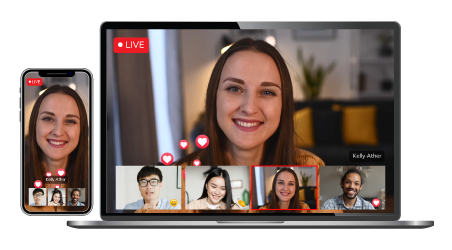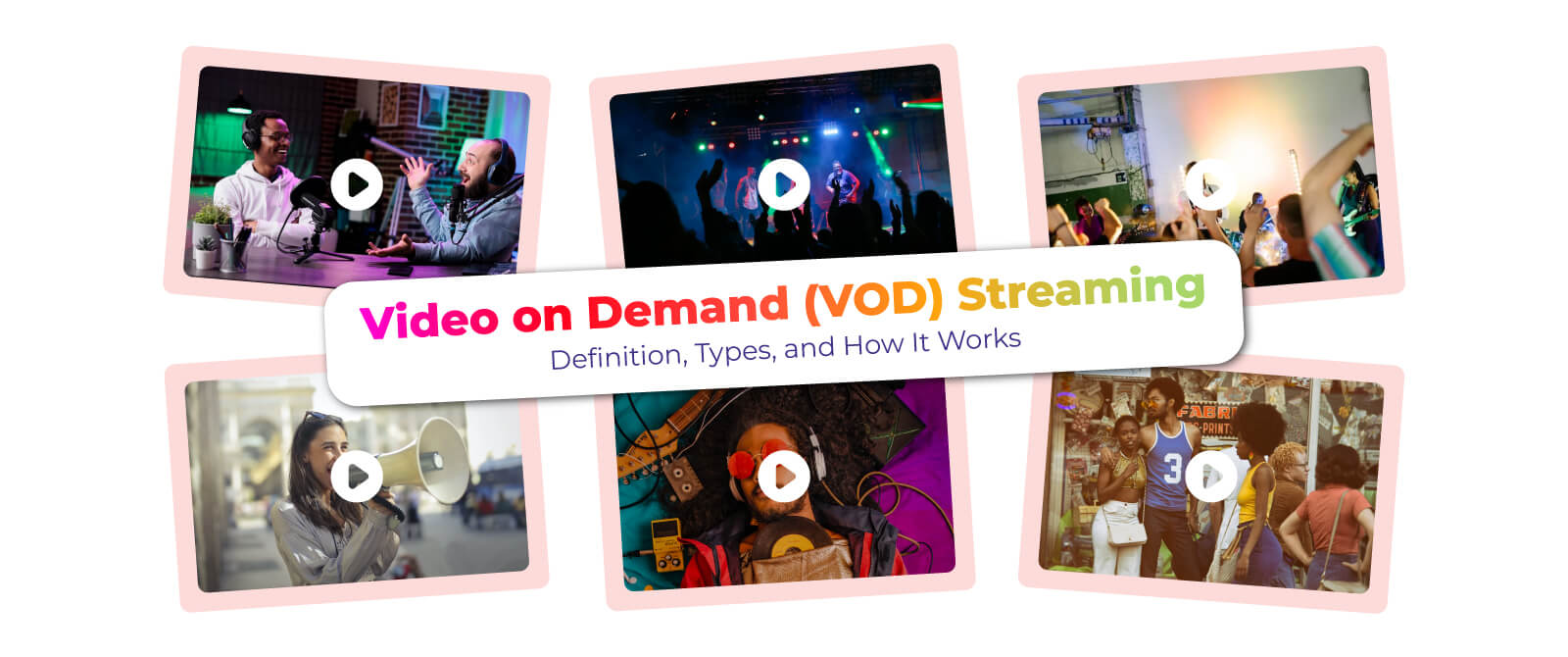In the fast-paced digital world, the consumption of video-audio content is significantly increasing. From booming social media to video on demand streaming (VOD) it has seen rapid growth and become an essential part of our lives. As per many reports and statistics, it has seen that video video-sharing platforms like YouTube, Instagram (which is both a photo and video-sharing platform), Facebook, and others give access to a wide range of content for users to consume. Although they are not meant for that. Even YouTube officials claim that around 5 billion videos are consumed by users every day. Furthermore, real video-on-demand streaming platforms like Netflix, Apple TV, Disney+, and others offer an unparalleled level of flexibility and convenience.
Here in this blog, we are going to explore the many added advantages, key components, differences with similar terms, types of video-on-demand platforms, and what makes it an essential part of our digital landscape. So, let’s get started;
Video on Demand Streaming: The Rise of Modern-Age Video Watching
If you look back to the days when Televisions, video players, cassettes, DVDs, and other ways of on-demand video content were available. But in the modern age, an array of video-on-demand streaming platforms are available, and that too on a single click. What’s all this? The rise of the modern age of content-watching scenarios. Well, VOD streaming has restructured many industries including entertainment. Now the viewers have the power to choose what they watch, and when they watch it.
It is said that every technology takes time to spread and to be in the hands of people with time. But this isn’t the case with the video on demand streaming services. Easy internet accessibility and user-friendly platforms made it possible. We will discuss all these video on demand platforms further in this blog, so keep tuned with us till the last;
What Is Video on Demand Streaming?
Video-on-demand streaming is a kind of modern technology that allows viewers to choose and watch video content based on their preferences and timings. Unlike traditional broadcasting, where content is scheduled and viewers have to watch at a specific time. The VOD lets the viewers access a wide range of video content libraries, such as movies, educational videos, music, and others. Every VOD service provider offers flexibility to the audience to watch their favorite content anytime, anyplace, and on any device supporting the internet. With the help of generative AI development services, content creators can now tailor their offerings to individual viewers, creating personalized experiences like never before.
Types of Video-on-Demand Streaming
Video on Demand streaming technology in digital content has revolutionized the way content is consumed. In short, it offers a plethora of options and varieties that cater to diverse audience needs. You can enjoy your favorite or newly launched movies, TV shows, and other video content at your convenience. Here, we have explored the various types of Video on Demand services available today:
1. Transactional Video on Demand (TVoD)
Transactional video on demand or TVoD is a type of video on demand that allows users to rent or purchase video content based on their needs. For example; You can buy or rent movies on YouTube. The users can pay a sum of money for the lifetime purchase or for a limited time, typically 24 to 48 hours. Talking about the popular video-on-demand streaming platforms Amazon Prime Video or Apple iTunes can be named.
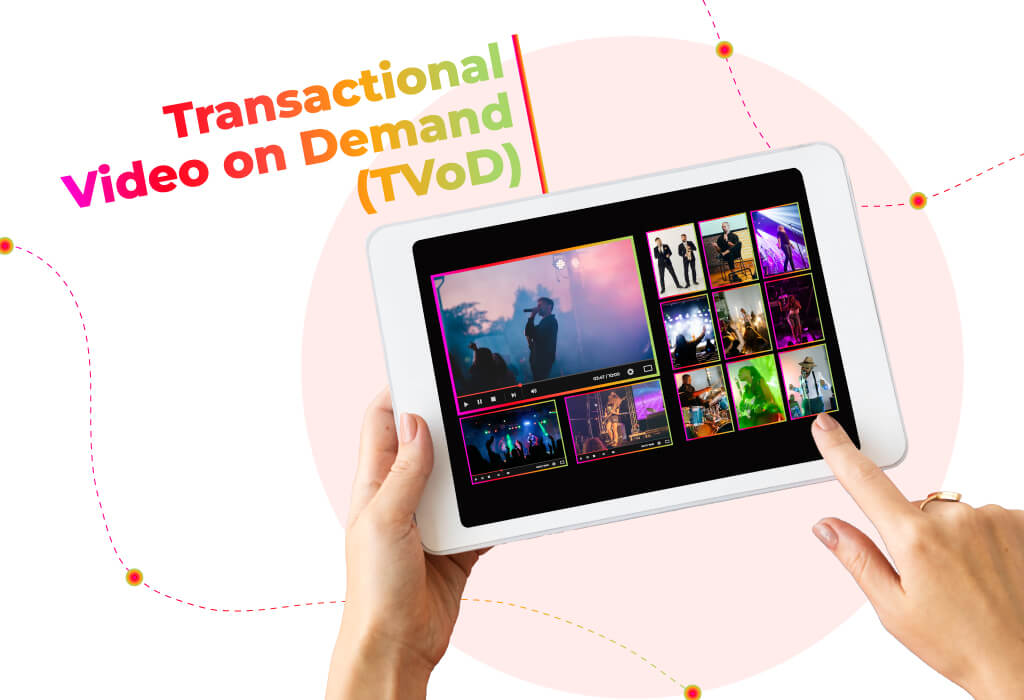
2. Subscription Video on Demand (SVoD):
The SVoD or subscription-based video-on-demand service comprises a wide range of content libraries. As the name itself suggests, this is a monthly subscription-based platform. Subscribers have unlimited access to movies, TV series, documentaries, and more. Here are the video on demand solution examples include; Netflix, Hulu, Disney+, and HBO Max.
3. Ad-Supported Video on Demand (AVoD)
There are many free platforms available that are known as AVoD platforms. This is free for the users but is supported by advertisements. Without paying any charges the viewers can enjoy the content (sometimes with limited access) but have to encounter ads in between. For example on YouTube you can watch many types of content but with ads.
4. Hybrid Models
There are many types of video-on-demand platforms that combine both elements. Like Hulu’ which is a combination of subscription-based and ad-supported plans, allowing users to choose their preferred experience.
5. Live Streaming VoD (LSVoD)
Now at last we come to LSVoD services that focus on live-streaming events. For instance, sporting events occur live and streaming it on a platform where users can enjoy the matches is known to be live streaming VoD. Not just that events like music concerts, news broadcasts, and others are also part of it. Users can access real-time content or catch up later on demand. ESPN+ and DAZN are examples of LSVoD platforms.
These five are the most well-known types of video-on-demand platforms and best represent the various varieties. Besides these, many other platforms are present, but they may be a combination of one or two types or slightly different, or it is better to say that some might include everything. Now, let’s understand the core difference between streaming and video on demand.
Video on Demand vs. Streaming
Video on Demand (VoD) and streaming are often used interchangeably, but they represent distinct concepts in the world of digital content consumption. Let’s explore the key differences between Video on Demand and streaming:
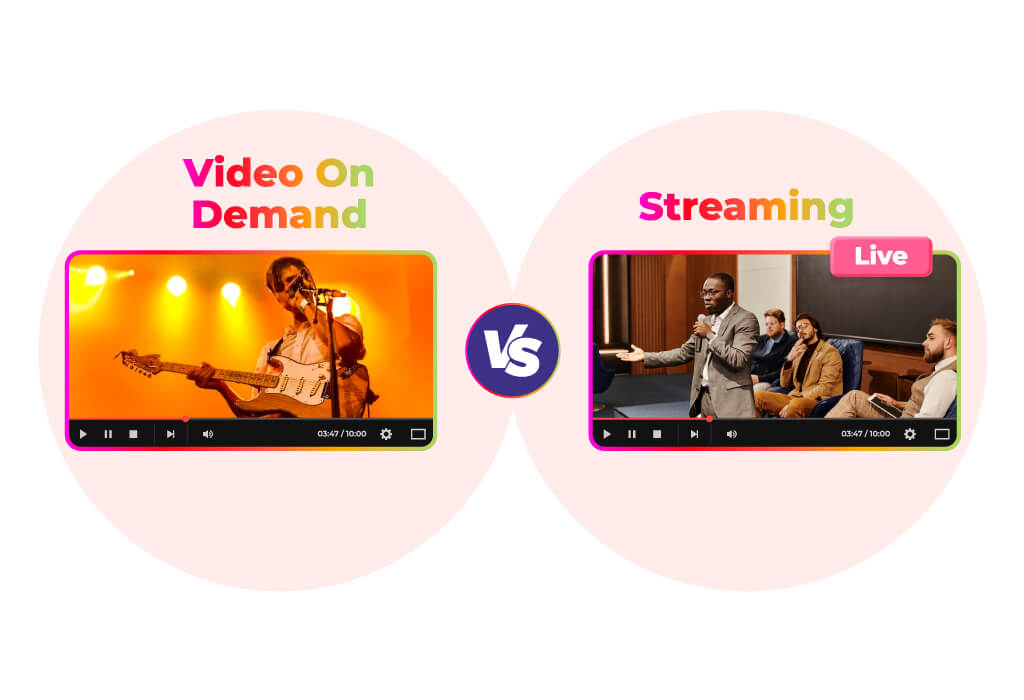
Both terms Video on Demand (VoD) and streaming are often used interchangeably. However, both are different from each other and distinct concepts in the realm of digital content consumption. Let’s explore the key differences between these two, videos on demand vs. streaming.
Video on Demand (VoD)
Video on demand specifically refers to services that allow users to request videos on demand. This is also flexible and at the user’s convenience in terms of time. For example; the viewers can control the content and choose based on their preferences.
- It includes various models, such as TVoD (renting or purchasing individual titles), SVoD (subscription-based access to a library), and AVoD (free access with ads).
- VoD content is often available for a specified duration, after which it may expire (in the case of TVoD).
Streaming
Streaming is a simple yet traditional concept where the users don’t have to download the content. They can simply watch the content in real-time over the internet. Sometimes streaming is also used under the umbrella of live streaming services.
- This is quite focused on watching the live streaming content like the sporting events or sessions over the YouTube video, or a TV show episode as it’s being transmitted.
- In real-time thousands of TV shows, movies, serials, dramas, and various other types of content are streamed live (which is pre-recorded in some cases). It offers a more continuous and spontaneous viewing experience
In short, both video-on-demand and streaming encompass a wide range of content on specified platforms. Both primarily focus on the real-time delivery of audio or video content over the Internet. However, it is completely observed that the impact they have marked on the viewers and their behavior of consuming digital media is significant. Overall it provides the utmost convenience and flexibility to choose at their best timings.
Key Components of Video On Demand Streaming
To understand the mechanics and functionality of VOD streaming, let’s break down its essential components:
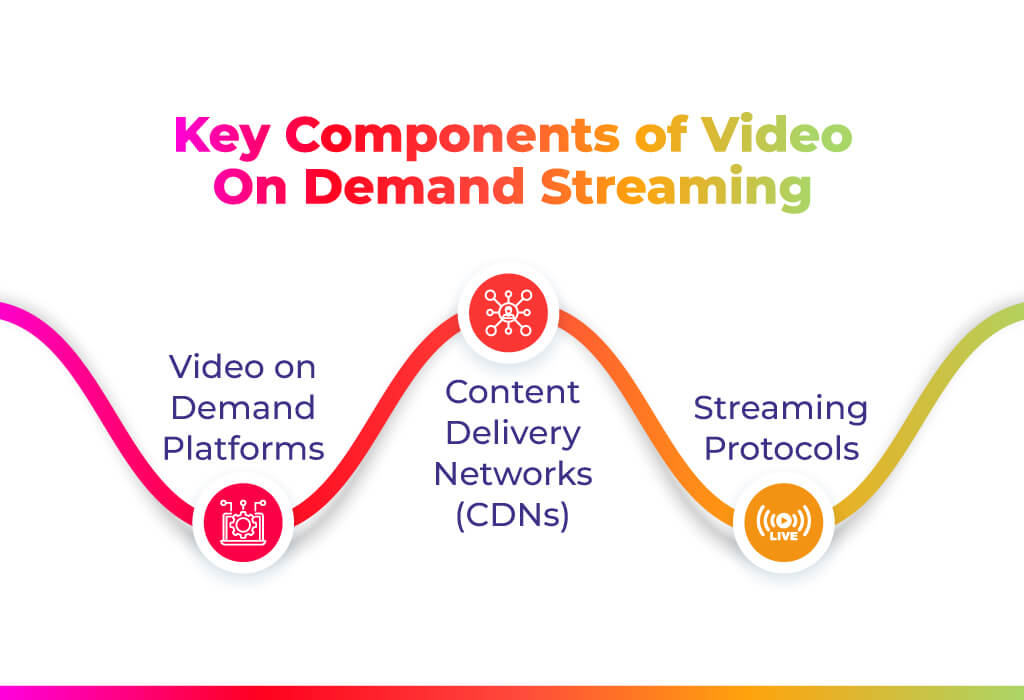
1. Video on Demand Platforms
These platforms host an extensive catalog of videos. They can either be stand-alone services, like Netflix, Amazon Prime Video and Disney+ or integrated with cable and satellite television services. VOD platforms are successful if they offer an intuitive interface, personalized suggestions, and diverse content to suit a variety of preferences and tastes.
2. Content Delivery Networks (CDNs)
Content Delivery Networks are a critical part of VOD streaming. The CDN is a geographically dispersed network of servers that stores and delivers video efficiently. The CDN closest to the location of the user delivers video content to ensure smooth playback.
3. Streaming Protocols
VOD relies on a variety of streaming protocols such as HTTP live streaming (HLS), and Dynamic Adaptive Streaming Over HTTP (DASH). The protocols adjust video quality dynamically based on internet speed and the device’s capabilities. This ensures uninterrupted viewing.
How VOD Streaming Works?
There are a few steps that easily take you through how the video on demand streaming works. So, let’s get started;
Content Upload: To make content available on VOD platforms, content providers upload videos to servers or cloud storage. These videos are then categorized and tagged for easy discovery.
User Selection: Viewers access the VOD platform through web browsers, mobile apps, or smart TV apps. They browse the content library and choose a video to watch.
CDN Delivery: When a video is selected, the CDN server nearest to the viewer’s location retrieves the content and begins delivering it in real time. This ensures low latency and minimal buffering.
Adaptive Streaming: Streaming protocols like HLS or DASH adapt the video quality to match the viewer’s internet speed, device, and screen size, ensuring a seamless viewing experience.
User Interaction: Viewers have control over playback, allowing them to pause, rewind, or fast forward through the content. This interactive experience is a hallmark of VOD streaming.
How to Choose the Right VOD Platform for Your Needs?
As the number of VOD services grows, it can become overwhelming for consumers to decide which platform best suits their viewing preferences and needs. This section will help guide readers through the process of choosing the right VOD service for them by comparing various factors, including content variety, pricing models, platform compatibility, and additional features. By providing readers with practical advice, this section will increase the blog’s usefulness and encourage engagement.
Assessing Content Library and Exclusivity
When choosing a VOD platform, one of the most important factors to consider is the content library. Major services like Netflix, Hulu, and Disney+ boast extensive collections, but it’s important to check whether they carry the specific content you’re interested in. For example, if you’re a fan of Disney movies, Disney+ would be the ideal choice, whereas someone who enjoys a broad mix of TV shows, movies, and documentaries might prefer Netflix or Amazon Prime Video. Additionally, exclusive content, such as original series and films, can be a significant factor in decision-making. Many platforms now offer exclusive, high-quality content that isn’t available anywhere else.
Pricing and Subscription Models
Different VOD platforms offer various pricing models. Subscription Video-on-demand (SVoD) platforms like Netflix and Hulu typically require a monthly fee, but the cost can vary based on the tier you choose (e.g., ad-supported vs. ad-free, standard vs. premium resolutions). Transactional Video-on-demand (TVoD) services like Apple iTunes or Google Play allow users to rent or purchase individual titles, making them ideal for those who don’t want to commit to a subscription. Ad-supported platforms (AVoD) such as YouTube allow viewers to watch for free but interrupt content with advertisements. Each pricing model offers its own advantages and is suited to different viewing habits.
Device Compatibility and Streaming Features
Another key consideration when choosing a VOD platform is compatibility with your devices. Most VOD services support a wide range of devices, including smartphones, tablets, smart TVs, laptops, and gaming consoles. However, it’s important to check whether your preferred service works with the specific devices you own. Additionally, some platforms offer more advanced features, such as offline viewing, simultaneous streaming on multiple devices, and high-definition video streaming. These features could be critical factors if you have specific viewing preferences or plan to share the service with others in your household.
Additional Features: Personalization and User Experience
User experience plays a major role in choosing a VOD platform. Services that provide personalized recommendations based on your viewing habits offer a more tailored experience. Platforms like Netflix and Hulu use sophisticated algorithms to suggest content that you are likely to enjoy, saving you time when browsing. Moreover, the ease of navigating the platform, finding content, and managing subscriptions should also be considered. Some platforms provide advanced search and filtering features, parental controls, and multi-user profiles, which can enhance the overall experience.
Customer Support and Free Trials
Before making a final decision, take into account the customer support options offered by the VOD platform. Look for services that provide responsive customer support through live chat, email, or phone. Furthermore, many VOD platforms offer free trials that allow users to explore the service before committing. This is a great way to test the content library, streaming quality, and user interface to ensure it meets your needs
Summing Up
Video on Demand (VOD) streaming has evolved into an integral part of our entertainment ecosystem, offering a wealth of content at our fingertips. Understanding its mechanics, from the role of VOD platforms to content delivery networks and streaming protocols, helps us appreciate the seamless and personalized viewing experiences it delivers. As VOD streaming continues to advance and diversify, we can expect even greater convenience and choice in how we access and enjoy our favorite video content. Hope you enjoy reading this blog. Thank you!
FAQs
In the film or entertainment industry the “Video on Demand” refers to the strategic distribution of content on platforms where viewers can choose and watch that content at their convenience.
Both the terms are different yet serve the same purpose of delivery of content on digital platforms. But the key difference is that OTT application development (Over-The-Top) is a broader term encompassing various streaming services, including VOD.
The basic difference lies in the flexibility and convenience both things give to the users. VOD gives flexibility to viewers to select and watch content on-demand whereas traditional broadcasting showcases scheduled programming found in traditional TV.
There are basically three types of video-on-demand streaming, and other than this are just merely combinations, they are;
Subscription VOD (SVOD)
Transactional VOD (TVOD)
Advertising-Supported VOD (AVOD).
Providing viewers the power to choose what and when they watch at their convenience has completely disrupted traditional media distribution models.
Connect with the Industry's Most Experienced
Live Streaming Service Providers.
